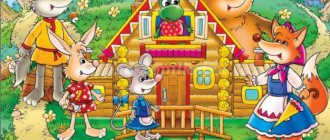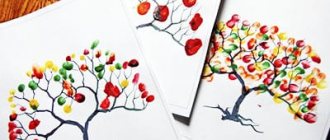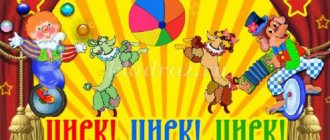Summary of a music lesson in the senior group. Journey to the autumn forest
Summary of organized educational activities “Journey to a fabulous autumn forest.”
Senior group Educational area : “Artistic and aesthetic development” Section : “Musical activity” Age group : senior (5 – 6 years) Compiled by: Yusupova L.D., music director of the highest qualification category This material will be useful to music directors, teachers of preschool educational institutions for organizing and conducting holidays, entertainment and music classes. The lesson notes have been developed for children of older groups (5 - 6 years old). Topic: “Journey to a fabulous autumn forest” Goal: to develop the creative abilities of preschool children. Objectives: Educational:
To form a musical culture based on familiarity with classical music.
To form children's vocabulary (thoughtful, gentle, lyrical), coherent speech and the ability to correctly construct sentences; activate speech, memory, logical thinking. Develop the skill of solo singing with musical accompaniment. Developmental:
Develop the skill of perceiving classical music through musical and rhythmic movements.
Develop the ability to identify a piece of music by its musical introduction. Develop breathing, pitch and rhythmic hearing; skill in playing children's musical instruments. Educational:
Create conditions for fostering a sense of mutual assistance, understanding and camaraderie.
Integration of areas: “Cognitive development”, “Socio-communicative development”, “Speech development”. Means of implementation: - laptop, stereo system; - tambourine; - toy bear; - flat carrots with a mirror according to the number of children; — yellow scarves for dance improvisation; - children's musical instruments. Preliminary work: - listening to the work “October. Autumn Song" from the album "Seasons" by P. Tchaikovsky; — acquaintance with the biography and work of V. Shainsky; — watching the cartoon “Shake!” Hello!"; - learning valeological songs with children - chants “Tryamdi-song”, “Good morning!” HE. Arsenevskaya; - learning songs “Song about us” by muses. S.V. Kaptyukhova, “Dear native land” music. T.V. Bokach. Repertoire: Listening – the play “October.
Autumn Song" music. P.I. Tchaikovsky. Play at the DMI – “Autumn Tale” lyrics. HE. Arsenevskaya. Chanting – valeological song – chanting “Good morning!” sl. and music HE. Arsenevskaya. Singing - “Song about us” music. S.V. Kaptyukhova; “Dear native land” muses. T.V. Bokach. MRD – dance “Friendship” bash.nar.mel. Musical game - “In the forest” music. etc. E. Senchenko Move.
I – Introductory part. Children enter the hall to the song “Smile” by the muses. V. Shainsky Musical director (hereinafter M.r.): Good morning, children! What's your mood today? Children: Good, kind. (Perhaps one of the children will say that they are in a bad mood) M.R.: I really want to inform you that today an unusual guest came to our kindergarten. V. Shainsky’s song “Clouds, white-maned horses” plays in the background
M.R.: Children, do you recognize him? Children: Teddy bear! M.R.: That’s right, the bear cub from the familiar cartoon “Shake!” Hello!" Bear: Hello, children, I'm so glad to meet you that I want to sing! M.R.: So let's sing and say hello to everyone with a cheerful song - the chant "Good morning!"
The music director and children perform a valeological song - the chant “Good morning!” sl. and music HE. Arsenevskaya Motivation. Bear: What a joyful song and you sang it amicably and cheerfully! Great!!! Children, I’m hurrying to the Hare’s birthday, I want to please him with a gift from the magical land of “Tili-mili-tryamdiy”! And he lives in a magical forest. But I’m a little scared to go alone, maybe you can join me in some friendly company?! M.R.: Children, what do you say, should we help Bear? Children: Yes! M.R.: Are we going on a journey? Children: Yes! M.R.: On the way, you and I will do a fun warm-up. Ralina will show us what movements we will perform and how: side step, side canter and hops. Demonstration of movements by a child. M.R.: Now we do everything together. Be careful. We will perform the movements rhythmically, expressively, to the music, and we will change movements at the signal of the tambourine. II – Main part. MRD “Fun warm-up” Children perform movements to the music, changing them at the signal of the tambourine:
- Jumping.
- Added step. - Side gallop. The teacher conducts individual work with children. Game at DMI. M.R.: So we came to the autumn fairy-tale and magical forest. And some adventures are already waiting for us! So these are the musical stumps that greet us, let’s sit down and relax after a long journey? Children: Yes! Educator: Children, do you want to amuse Little Bear and tell him a good musical fairy tale?! Children: We really want to! M.R.: I propose to play “Autumn Tale” in the orchestra. Take apart the instruments, and Little Bear will choose the conductor for us. Do you agree? Children: Yes, we agree! The bear chooses the conductor as a rhyme. Children take instruments and play them in accordance with the text under the guidance of a child conductor.
Orchestra “Autumn Tale” lyrics. HE. Arsenyevskaya, Russian Nar.mel. “Oh, you canopy” Bear: Thank you, children, I really liked your autumn fairy tale. Children place musical instruments on chairs - “stumps” and, together with the teacher and Little Bear, approach the music director. Hearing. M.R.: Look, children, how beautiful it is in the autumn forest. Even though late autumn has already arrived, the forest still pleases us with its beauty, birdsong and clean air, don’t you agree, children? Children: Yes! M.R.: Let's breathe. Breathing exercise “Breathing in the forest” Inhale through the nose, hands rise up and exhale through the mouth, hands down. M.R.: Children, let's sit down on the chairs and listen to the orchestra perform a fragment of the musical play “Autumn Song” by composer P.I. Tchaikovsky. Children listen to a fragment of P. I. Tchaikovsky’s play “October. Autumn Song." M.R.: Children, what did the music sound like? Children: Calmly, gently, affectionately. M.R.: What feelings does music convey? What natural phenomenon does the music tell about? Children: Music conveys sadness that summer is leaving, it’s getting cold, leaves are falling, winter is approaching. M.R.: “Autumn Song” is one of the best plays “The Seasons” by P.I. Tchaikovsky. Its melody is the most lyrical, gentle, thoughtful and a little sad, it talks about the fading beauty of autumn nature. Children, how can you convey your impressions of music? Children: You can draw a picture, read a poem or perform a dance. M.R.: That’s right, you want to depict the beauty of autumn nature with dance improvisation to the familiar play by composer P. I. Tchaikovsky “October. Autumn Song." Children: Yes, with pleasure! M.R.: Children, please tell us how you will move to the music? Children: Easy, on tiptoes, calm, gentle, lyrical, affectionate, smooth. Active listening.
The play “October” is performed. Autumn Song" by P. I. Tchaikovsky Children perform dance movements with scarves, and then put them in a basket. M.R.: Children, you very tenderly and lyrically depicted the fall of autumn leaves, did you like it yourself? Children: Yes! M.R.: And you, Little Bear? Teddy Bear: Very beautiful! But I felt sad that you are so wonderful, friendly, and my friend, the Hare, is still not around. M.R.: So here he is! Hare (child): Hello, Little Bear, glad to see you! Little Bear: Hello, Hare, I have a gift for you from the magical land of “Tili-mili-tryamdiy”! I'll bring it now. The little bear takes out a basket of carrots and gives it to the child, the hare. Hare: Carrots! Thank you, Mishka! But are they somehow unusual?!
M.R.: What a miracle?! Children, have you seen carrots like these? Children: No, we didn’t see it! Mr.: These are mirror carrots, you need to handle them very carefully. Little bear, what are they for? Little Bear: These are magic carrots, they help your tongue do gymnastics! And the tongue needs gymnastics in order to speak correctly and clearly. I have a lot of magic carrots, enough for everyone! Take it! M.R.: Okay, little bear, we understand you, we’ll take the carrots and start the gymnastics! Children, take the carrots and show the Bear what we can do with our tongues. Articulation gymnastics: “Fence”, “Cup”, “Turkey” M.r.: Thank you, Misha, for the funny carrots. We designed our reeds for singing. Children, maybe we can give the Bear and the Hare a gift? Children: Yes! Mr.: Place the carrots in the basket and sit down on the chairs. Singing. M.R.: Let's remember a familiar song and tell our friends about us. We listen carefully to the melody, take our time and pronounce the words clearly. The teacher gives instructions on correct posture: “Legs together, backs straight, so that the song sounds!” Children sing the song “Song about us” by music. S.V. Kaptyukhova M.R.: Children, what is this song about? What feelings does this music convey? Children: The song is cheerful, kind, listening to it, you want to rejoice and sing. M.R.: Misha, did you like the song? Little Bear: Yes, the children sang loudly, together, and I just wanted to sing with you. M.R.: Well, now I suggest you listen to the melody of the next song, and tell Little Bear what it’s called, who the composer is, what the mood of the song is. The musical director performs the song “Dear Land, Dear” by muses. T. Bokach Children express their opinions about the content and nature of the music. Children: A song about our Motherland, about the Republic of Bashkortostan. The nature of the music is affectionate, calm, kind, gentle, lyrical. M.R.: Children, do you want to perform it with soloists? Children: Yes! M.R.: Who wants to be a soloist? Come out, please. The teacher helps you choose soloists and gives instructions on correct posture. M.R.: Children, what will the soloists perform? Children: Verse. M.R.: What will the rest of the children perform? Children: Chorus. M.R.: Okay, right. We listen carefully to the introduction. Children perform the song “Dear Land, Dear” by muses. T. Bokach M.r.: Children, you all did your best, you sang the song expressively, tenderly, affectionately. They joined the song at the same time as the music started. Please tell us what else you can please our friends with?! Children: Play! Dance! Little Bear: How cool, and I want to dance! M.R.: Boys, invite the girls to dance. Educator: ......, please show me how we will perform the Bashkir dance movement: triple stomp. (Child demonstrates the movement) Educator: Now we do everything together. Be careful. We will perform the movements rhythmically and expressively. The back is straight, we don’t look at the floor, we keep the distance between the couples. Children perform the Polka dance Bashk.nar.mel. At the end of the dance, the boys escort the girls to their chairs and sit next to them. M.R.: Little Bear, our children sang and danced, but haven’t played yet. Children, do you want to play with the Hare and the Bear? Children: Yes! Educator: We know an interesting round dance game “In the Forest”. Children, join hands and start a round dance. We have a hare, we need to choose a cuckoo and a hedgehog. The teacher puts masks on the children. Children play the game "In the Forest" music. etc. E. Senchenko
III – Final part. M.R.: So our journey through the fairy-tale, magical forest has ended. Little Bear, we helped you meet the Hare, and it’s time for us to return to kindergarten. Children, did you like it in the forest? Children: I liked it very much! M.R.: What is your mood now? Children: Cheerful, joyful, sunny, kind, fabulous, good. M.R.: Let's remember what helped us get into the magical and fairy-tale forest today? Children: Fun warm-up, autumn fairy tale with musical instruments, songs, Bashkir dance, game. M.R.: In a word, wonderful music. And today you were very attentive, active and expressive. I wish you all a good autumn mood, love and take care of your native land, believe in fairy tales and love music. This is the one who will help us return to kindergarten! We set off on the way back, scattered like peas. Children perform the song “Autumn has come” by music. S. Nasaulenko Children and teacher sing “Goodbye” and leave the hall to the music.
We recommend watching:
Speech therapy lesson in the senior group on the topic: Autumn Lesson summary - excursions in the senior group of kindergarten. Journey to the autumn forest Summary of the lesson “Journey to the autumn forest” in the senior group Summary of the conversation on the topic Autumn in the senior group
Similar articles:
Summary of a lesson in the senior group on an autumn theme based on the fairy tale “Apple” by V. Suteev
Summary of a lesson in the senior group on the topic “Harvest, vegetables, fruits”
Musical lesson on the theme “Sorceress Autumn”
Music lesson notes
"Sorceress Autumn"
Senior group MBDOU kindergarten "Crane"
Musical director Vlasova O.I.
Target:
consolidate children’s existing knowledge about autumn, show the beauty of autumn through works of art (classical music, paintings by artists, through songs, music and games).
Program content.
1.
Continue to develop the culture of movements to music, the ability to change lanes based on a signal, improve children’s plasticity based on conscious perception of music, the ability to move according to the nature of the music, and combine various movements. (Circling, running on toes, changing from a large circle to a small one, moving from a stand on one knee, easy running like a snake).
2.
Improve the vocal apparatus, relying on the range, preserving the individuality of the child’s voice type, cultivate a culture of singing depending on the figurative and poetic nature of the song, continue to develop the ability to sing collectively in subgroups.
To promote further mastery of the techniques of playing children's musical performances, to create conditions for staging songs.
3.
Cultivate interest in musical and artistic arts, the ability to feel the expressive features of musical and artistic images. Foster a culture of behavior, maintain a positive emotional mood and friendly attitude of all participants in the lesson.
Methodological techniques.
- Expressive performance of musical works by the teacher.
- Artistic word, display of paintings.
- Motor-speech exercise “Let's draw autumn.”
- An exercise to distinguish the dynamics of the sound of music.
- Breathing exercises.
- Display of the composer's portrait.
- Listening to a sample of a classical piece.
- Conversation with children.
- Voice singing exercise.
- Articulation gymnastics.
- Didactic game “Where are the notes hidden?”
- Laying out durations on a flannelgraph.
- Game at DMI.
- Singing in subgroups. (Boys and girls)
- Outdoor game.
- Posting a collective drawing.
- Vocabulary work. (“Autumn Song” by P. Aikovsky; photo reporter)
Material and equipment:
leaflets according to the number of children, easel, playbook, TSO (music center), children's musical instruments, portrait of the composer, flannelgraph.
A picture for demonstration, a sketch for a collective picture (with separate component fragments for all children).
Progress of the lesson
Children run into the hall to the music with pieces of paper in their hands and perform dance movements, changing from a large circle to a small one, running like a snake, moving from a position standing on one knee, smooth swings alternating their arms. After finishing the composition, the leaves are passed through and given to the teacher. Stand in a circle
Educator
: Guys, we came to the music room, let's say hello to everyone.
Children say loudly: Hello!
Musical director
: Let's remember the musical greeting!
Greeting “Hello!” in halftones.
Educator
: Dear guys, today our lesson is dedicated to a wonderful phenomenon. and listen to the riddle about this:
Author: Tarabrina E.V.
The sorceress walked around the world, In turn, summer changed! I decorated flowers and trees and gardens! Well, tell me guys, what is the answer here?
The children give the answer.
Educator
: Please (child's name) read us a poem about autumn.
Guys:
Autumn walked along the path and found different colors. I decorated the entire forest from the path to the sky!
Musical director
: Guys, what is autumn like? Let's talk briefly.
Children list
(rainy, colorful, productive, etc.)
Musical director
: Let's play the game “Draw Autumn”.
Motor-speech exercise “Draw autumn.” Author: Tarabrina E.V.
— Stir the paint (circular movements of both hands).
- Shake off the excess (shaking movements of the hands).
— Let’s draw autumn (the artist’s drawing movements).
— Drops outside the window (point movements of both hands with fingers).
- Colored rainbow (draw a semicircle with your palm).
— Blue river (wave-like movements of the hand).
- Lots of autumn colors (spreads his arms to the sides, showing “many”).
- Choose any one (two hands forward with thumbs up).
Musical director
: What a bright picture!
Educator:
And now we will imagine for a moment that we are in the forest, and we are all beautiful autumn trees. The music of the wind sounds. Light, slightly tenderly touching the leaves.
Educator:
Guys, can you hear the sound of the breeze?
The music director
performs a musical passage to distinguish dynamic shades (a quiet gentle sound is replaced by stormy chords of another musical passage).
Educator
: Well, guys, have you noticed how quickly the weather changes in the fall, the light breeze was replaced by what? (Children's answers)
Educator:
You noticed - I'm glad.
Musical director
: And now we are back in the music room and I invite you to the chairs. (Children sit on chairs one by one)
The teacher gives instructions on correct posture.
Musical director
: Let's play with raindrops. (Breathing exercises on strings)
The breeze blows a little, weak and long. (Do the exercise)
And now the wind is blowing, getting stronger, stronger. (Exhale deeply)
Well done, you completed the exercise (the drops are removed).
We will talk about autumn later, but now let's look at it through the eyes of a photojournalist, a photographer.
What is shown in the photo?
What season?
Why do you think so?
Children answer with complete answers by raising their hand.
Guys, why is autumn called the sorceress?
The beauty of autumn was admired by poets and artists, and, of course, by photographers and composers.
Today we will listen to a work by the wonderful Russian composer P.I. Tchaikovsky (portrait show) about autumn it is called “Autumn Song”
We listen carefully, you can close your eyes, sit comfortably, listen and think. And then we'll talk a little.
Listening to music
Musical director:
You've listened to it, now tell me what kind of music it is?
How does it make us feel? What instrument did it sound like? What kind of autumn did the composer depict?
I'm glad you liked this piece. Let's repeat the piece again called “Autumn Song” by P.I. Chaikovsky.
Musical director:
You and I know songs about autumn, but before we sing, let’s sing. We try to sing cleanly, clearly pronouncing the syllables; our lips help to sing the song correctly.
“It’s been raining since morning at about five o’clock, only we’ll go for a walk if we take the zone!” Don't get wet in the rain! (Performed 2 times)
Now let’s perform the “silent song.”
Articulation gymnastics (silent song)
Musical director
: Now I think we are ready to sing a song about autumn.
I won’t say the name of the song, you will listen carefully to the introduction and pick up the song.
Remind me how we sing (conveying the character of the song, the mood, trying to correctly lead the melodic line and sing the words clearly).
Song “Oh, what autumn!” Z. Root
Musical director:
We already know this song well, what do you guys think, did you manage to convey the character of the song? Sing harmoniously? Of course you tried.
Educator:
Guys, in order to sing the next song we need to remember the notes. But the tricky notes are hidden from us, we need to find them.
Game “Find where the tricky notes are hidden?”
A didactic picture is placed on the easel.
Children look for where the notes are hidden, pronouncing their names (do, re, mi, fa, salt, la, si).
Well done! You completed the task.
Musical director:
Guys, do you know the duration of the song? You also ran away.
We need to put them in order.
The music director lays out a song with durations on the easel.
Musical director:
Let's clap the song. Did you find out what this song is?
Song “Mischievous sun in a golden shirt”.
Unknown author
Now we will perform this song along with playing noise percussion instruments
Grab your instruments and get ready to play.
The music director briefly evaluates the performance.
Musical director
: Well, of course, you all tried to be creative in how you planned to perform this song.
Musical director:
Guys, tell me what is the main gift that autumn gives us besides the beauty of nature?
Children
: Gives a generous harvest! And the harvest used to be sold at the fair. And for one more song we will go with you to the fair. What song will we sing?
Children:
“Where was Ivanushka”?
Song “Where was Ivanushka?
(Execution by subgroups)
Musical director:
We made a funny song
Educator:
Guys, we will be returning from the fair through the forest. And so that we don’t get bored while walking, we’ll play a game.
The game is called “Find your tree”
(similar to “Whose circle will gather faster?”)
Musical director:
Well guys, our lesson is over.
What new did you learn, what did you find interesting, what did you like, what did you remember?
I'm glad you enjoyed the lesson.
Educator:
We are very glad that we learned and remembered so much about autumn, and we want to leave a picture as a souvenir. They said that autumn is an artist, let us also be a little artists
You and I will decorate the picture, bring it to life, add different colors, you will help, do you want to become an artist for a minute?
Children decorate the overall sketch of the painting with individual elements. (Music plays in the background)
Children give an assessment.
Musical director:
Thank you guys for your active participation in the lesson, maybe something didn’t work out for someone, it will definitely work out next time. Goodbye!





